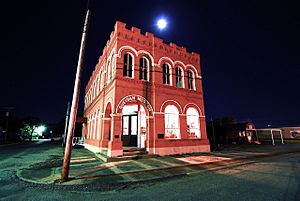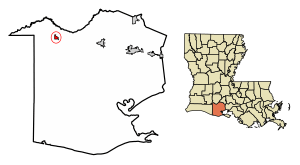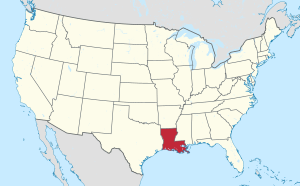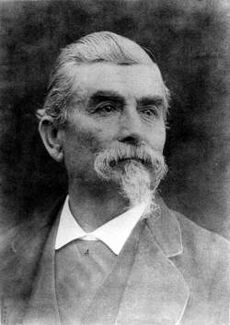Gueydan, Louisiana facts for kids
Quick facts for kids
Gueydan, Louisiana
|
|
|---|---|
|
Town
|
|
| Town of Gueydan | |
 |
|
| Motto(s):
"Duck Capital of America"
|
|

Location of Gueydan in Vermilion Parish, Louisiana.
|
|

Location of Louisiana in the United States
|
|
| Country | United States |
| State | Louisiana |
| Parish | Vermilion |
| Area | |
| • Total | 0.91 sq mi (2.36 km2) |
| • Land | 0.91 sq mi (2.36 km2) |
| • Water | 0.00 sq mi (0.00 km2) |
| Elevation | 7 ft (2 m) |
| Population
(2020)
|
|
| • Total | 1,165 |
| • Density | 1,280.22/sq mi (494.07/km2) |
| Time zone | UTC-6 (CST) |
| • Summer (DST) | UTC-5 (CDT) |
| Area code(s) | 337 |
| FIPS code | 22-32055 |
| Website | The Town of Gueydan, Louisiana |
Gueydan is a small town in Vermilion Parish, Louisiana, United States. It is often called the "Duck Capital of America." In 2020, about 1,165 people lived there.
Contents
History of Gueydan
For thousands of years, indigenous peoples (native groups) lived in the Louisiana area. They hunted animals and caught fish from the rivers. Later, the Attakapa and Chitimacha tribes lived here.
In the 1860s, a man named Jean Pierre Gueydan lived in Abbeville, Louisiana. He often came to this area to hunt many kinds of birds and animals. It was a great place for hunting.
In 1884, Jean Pierre and his brother François bought 40,000 acres of land. Surveyors had called it "sea marsh, unfit for cultivation." They bought it for a very low price.
By 1896, a small part of this land became known as the "Gueydan Pasture." It became a village when 250 people lived there. Jean Pierre Gueydan bought his brother's land and is known as the town's founder. In 1902, the village officially became the town of Gueydan. Many people in the town grew rice as their main crop.
Jean Pierre Gueydan knew that a railroad was important for rice farmers. He gave land to the Southern Pacific Railroad to build a train line. Soon after, he started selling land lots, and more settlers came to live in Gueydan.
The first irrigation pump in Louisiana was built near Gueydan. This pump helped bring water to thousands of acres of rice fields. This made the area a big producer of rice. Later, Italian immigrants came to work on the farms. Some of them started their own businesses in town, like grocery stores.
The first school in Gueydan opened in 1894. It was in Jean Pierre Gueydan's plantation house, St. Bennette. It started with 10 students.
Gueydan has faced many challenges. Fires in 1901, 1903, 1910, and 1927 caused a lot of damage. The worst event was the Flood of 1940. Heavy rains in August 1940 caused the whole town to flood. People who lived through it still remember the disaster. The area is very flat and close to the Gulf of Mexico, so it floods easily.
This area used to be low, marshy land called wetlands. These wetlands had many trees and bushes that could soak up floodwaters. Later, people built canals to drain water and help with farming. But these canals changed the natural wetlands. This made the town and rice fields more likely to flood.
Geography and Climate
Gueydan covers about 0.9 square miles (2.36 square kilometers) of land.
Local Climate
The weather in Gueydan has hot and humid summers. Winters are usually mild or cool. It has a humid subtropical climate. This means it gets a good amount of rain all year.
Who Lives in Gueydan?
| Historical population | |||
|---|---|---|---|
| Census | Pop. | %± | |
| 1900 | 376 | — | |
| 1910 | 1,081 | 187.5% | |
| 1920 | 1,233 | 14.1% | |
| 1930 | 1,313 | 6.5% | |
| 1940 | 1,506 | 14.7% | |
| 1950 | 2,041 | 35.5% | |
| 1960 | 2,156 | 5.6% | |
| 1970 | 1,984 | −8.0% | |
| 1980 | 1,695 | −14.6% | |
| 1990 | 1,611 | −5.0% | |
| 2000 | 1,598 | −0.8% | |
| 2010 | 1,398 | −12.5% | |
| 2020 | 1,165 | −16.7% | |
| U.S. Decennial Census | |||
In 2020, 1,165 people lived in Gueydan. This was a decrease from 1,598 people in 2000.
Most people in Gueydan are White. About 82.83% of the population is White (not Hispanic). About 13.48% are Black or African American. A small number of people are of other backgrounds.
Fun Things to Do
The Duck Festival
Gueydan is famous for its annual Duck Festival. It happens the weekend before Labor Day. Because of this festival, the town is officially known as the "Duck Capital of America." During the festival, there are competitions for duck and goose calling.
Notable People from Gueydan
- Iron Eyes Cody (Espera de Corti) grew up here. He became an actor and played Native American characters in many movies.
- Bob Hensgens was the mayor of Gueydan. He is now a state representative for Louisiana.
- Jeannette Knoll was a judge on the Louisiana Supreme Court. She lived in Gueydan when she was young.
- Nathan Abshire was a famous Cajun accordion player. He was born near Gueydan.
- Frank Glasgow Tinker was an American pilot. He volunteered to fly planes during the Spanish Civil War.
See also
 In Spanish: Gueydan para niños
In Spanish: Gueydan para niños


